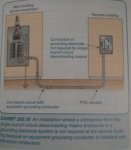MRKN
Member
- Location
- California, USA
Clarification on "branch circuit" and "feeder" with regards to 2011 ed. 250.32(A)
Hi,
Per Exhibit 250.18, referenced in the 2011 ed. 250.32(A) Exception item (shown attached), I am a little confused as to the use of the word "branch circuit". It seems to be that by definition, if you are using a branch circuit to supply a sub panel, or any OCPD as shown in the Exhibit, it is no longer a branch circuit, but a feeder.
Please advise.
Hi,
Per Exhibit 250.18, referenced in the 2011 ed. 250.32(A) Exception item (shown attached), I am a little confused as to the use of the word "branch circuit". It seems to be that by definition, if you are using a branch circuit to supply a sub panel, or any OCPD as shown in the Exhibit, it is no longer a branch circuit, but a feeder.
Please advise.


